It’s a fine May morning, and until a couple of minutes ago, the search for ornate box turtles here at the Conservancy’s Nachusa Grasslands Preserve in Central Illinois was going extremely well. We are up to 16 turtles on the morning so far.
Unfortunately, progress has come to a halt because the field assistants found the remains of something that might once have been a bison. And now they’re rolling in it. With glee.
“Well,” says John Rucker, as he surveys his mucky, happy charges. “Getting that smell out of their coats is going to be a project.”
Rucker gives a few quick commands and his field assistants – four female Boykin spaniels – finish their impromptu break, and get back to the job at hand: namely, tracking and retrieving every ornate box turtle they can find in these restored and remnant native prairies.
Yes, retrieving. I expected the tracking. The retrieving part came as a bit of a shock.
“The dogs find more ornates in two or three hours than we’d probably find in a whole week or even longer,” says Matt Allender, the team leader for the University of Illinois scientists at Nachusa this week, many of whom are grad students, doctoral candidates and post docs working on projects related to reptile health. “We couldn’t do this project without John and the turtle dogs. They’re part of the team.”
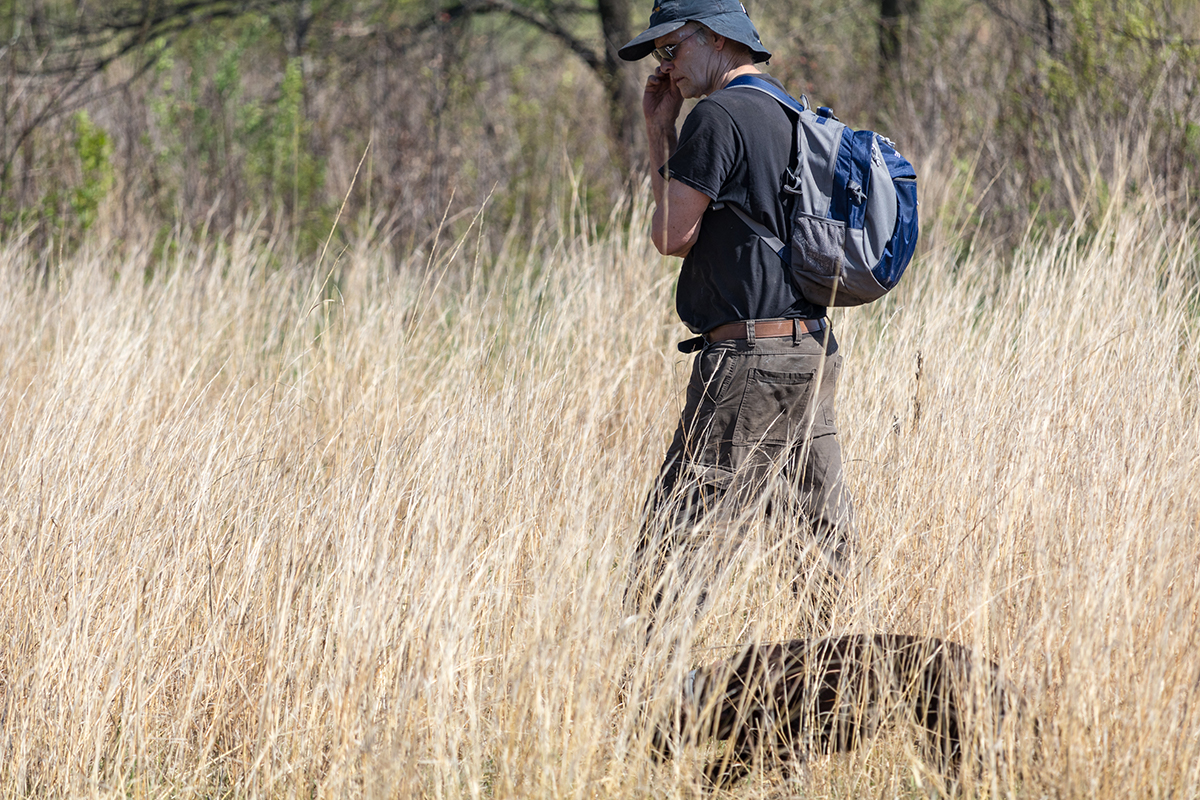
These medium-sized spaniels with their amber eyes and thick, brown coats that shine like copper in the sunshine were originally bred in South Carolina for bird hunting. But the breed also produces, as Rucker discovered by accident some years ago, a few special individuals who turn out to make excellent, well, turtle retrievers.
“They have very soft mouths,” Rucker explains as Jenny Wren (who has been finding the majority of turtles this morning) lopes up with the latest ornate find, which will be turtle number 19 by my count.
Jenny sits obediently at John’s feet, holding up her prize – like it’s some kind of reptilian tennis ball — and I can see that her tongue is between her bottom teeth and the turtle’s plastron (the bottom of its shell). She’s holding the ornate so lightly, I don’t feel any resistance when I slip it from her mouth. And the turtle shell is not even slobbery like a tennis ball would be.
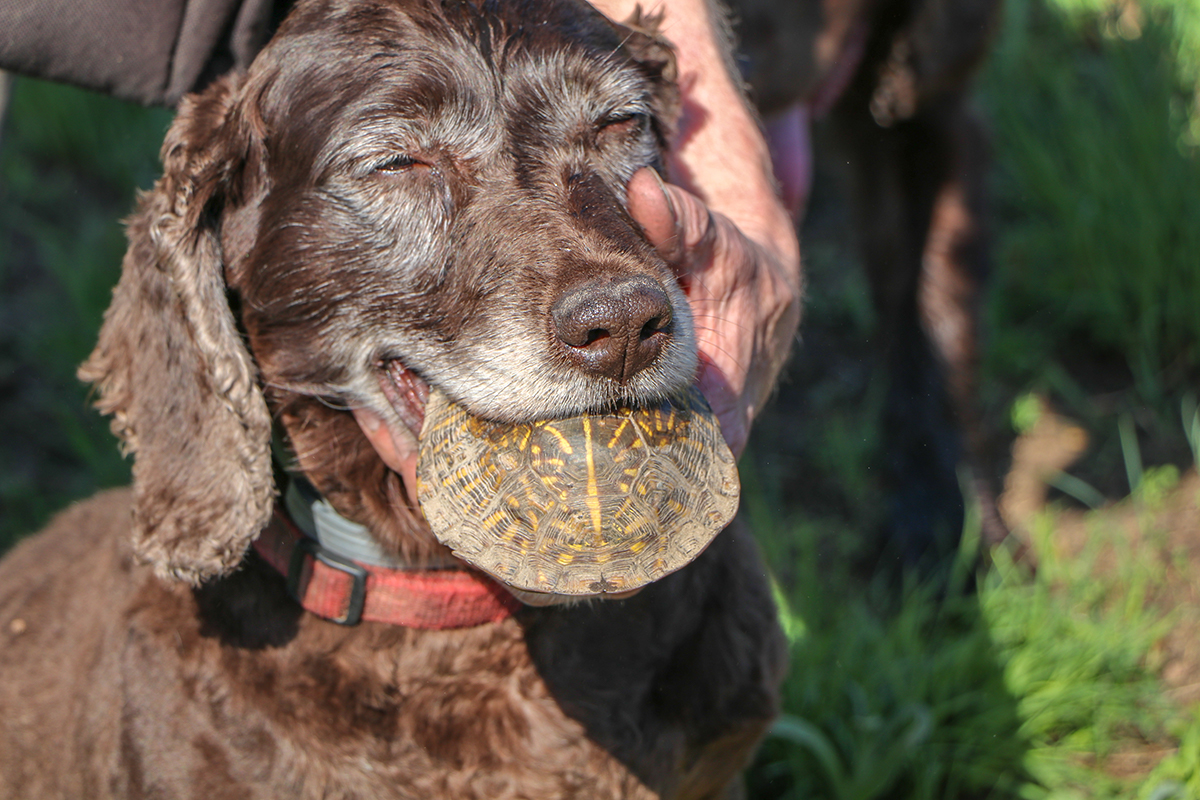
“I have the turtle,” I say to one of the nearby scientists who is busy logging the exact GPS coordinates where Jenny Wren first found the turtle. It’s important to record the location precisely so the scientists, once they finish their tests, can return the turtles (by human hand this time) to the exact same place they were originally found.
“See?” Rucker says as he bends down to pet and praise Jenny. “The dogs are very gentle and they carry the turtles without injuring them. Ornates, blandings, Eastern box turtles, wood turtles, they can track and retrieve them all.”
Ornate box turtles, which tend to grow to around five to seven inches in length, are known for their beautiful backs (the carapace). To me, their shells look like a night sky full of yellow starbursts. They are true box turtles – one of the few turtles capable of completely sealing themselves inside their shells for protection from predators.
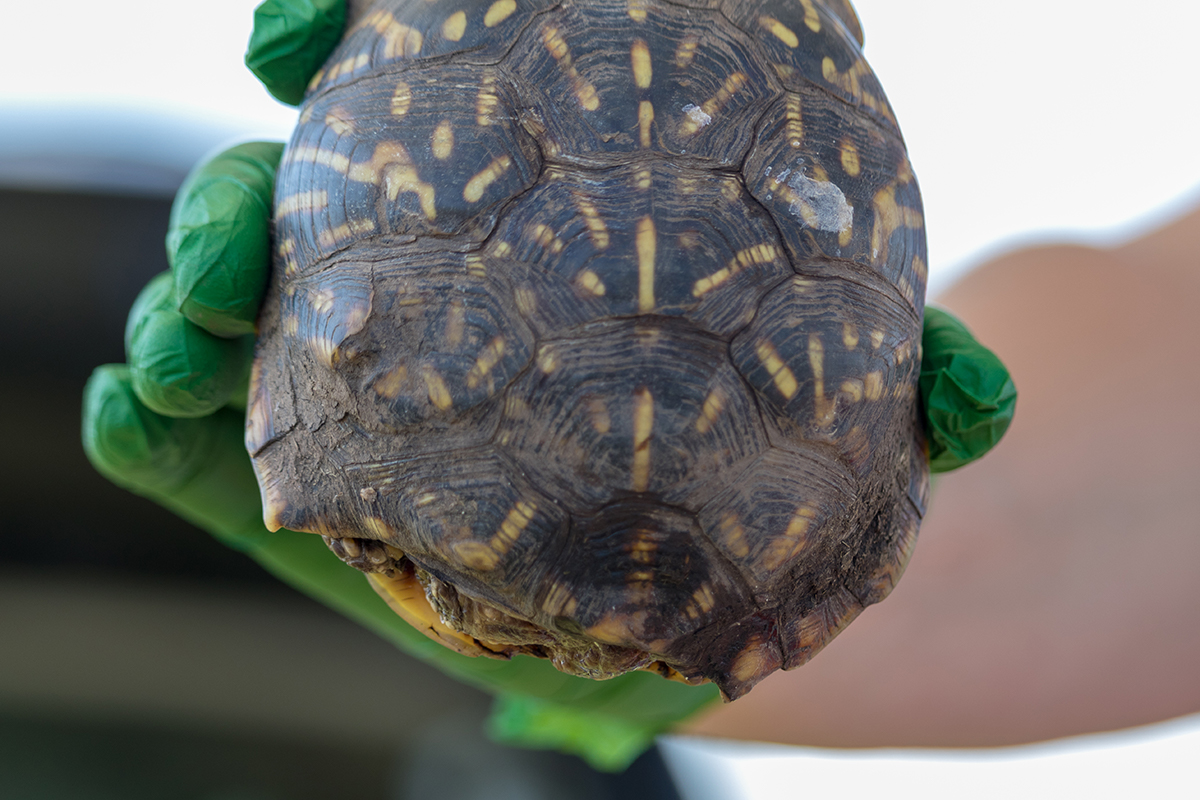
Which helps protect the adult turtles from, say, raccoons and badgers, but does little to thwart farm machinery and cars. The conversion of native Illinois prairie to farmland and pasture is one of the main reasons ornates are listed as a threatened species in Illinois.
Nachusa Grasslands has several populations of ornates, but Bill Kleiman, the preserve manager, would like to know more about how healthy and viable they are. Are there enough turtles of different ages to sustain ornates on the preserve into the foreseeable future? Are they healthy? Diseased? Injured? He needs to know more to inform the way the preserve is managed.
The bottom line, he says, is that “we want a lot more turtles here, and to make that possible, we need to understand many different aspects of our current population.”
It’s that need for more data – more evidence to inform the science behind the Preserve’s ongoing restoration and management — that brings Allender and his crew, and John Rucker and his spaniels to Nachusa this week. The scientists have set up a temporary field station under a tan canvas tent where they’ll be assessing all the turtles they collect.
Honestly, the set up – with its colorful canvas camp chairs and folding tables covered with scientific instruments — looks like a cross between a high-tech lab and a tailgate party. And as I watch the scientists go to work on the specimens they’ve collected this morning (22 by my last count), I keep thinking it’s a little like all those stories people tell about alien abductions. Only with turtles.
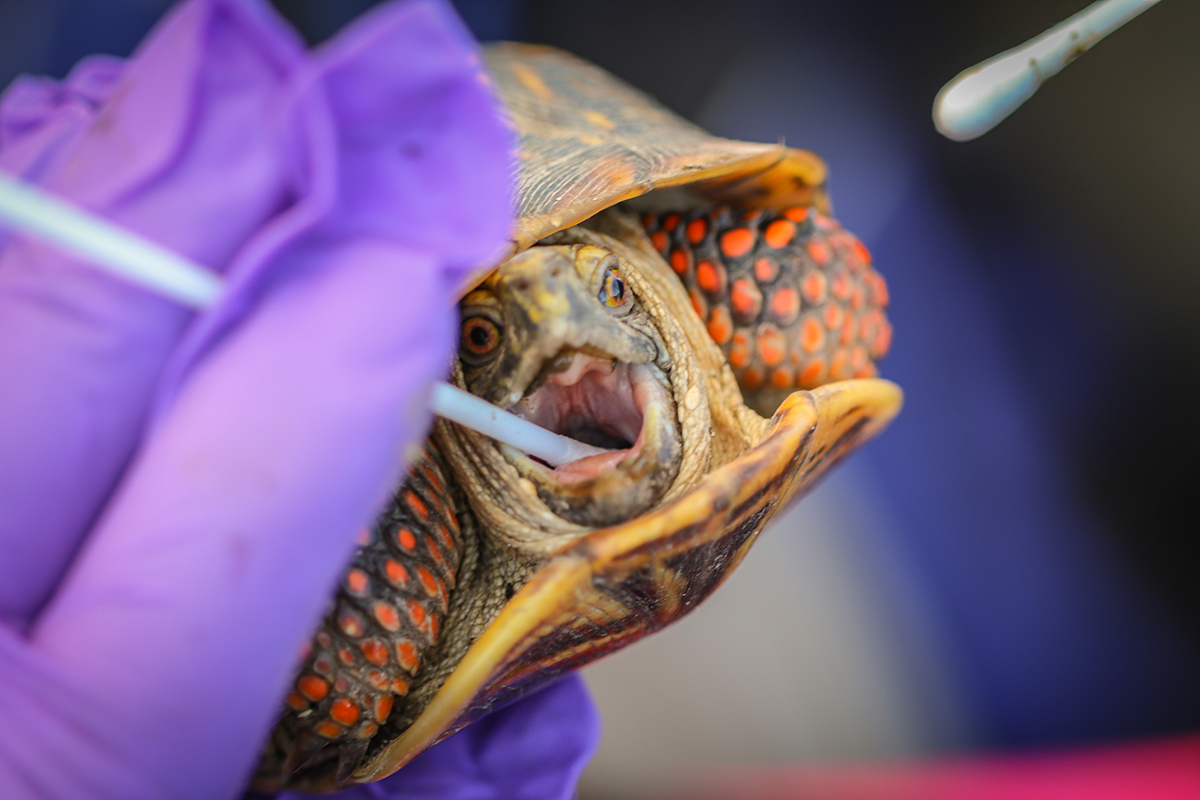
There are tackle boxes full of test tubes and slides, selections of syringes for drawing turtle blood, pipettes, cotton-tipped swabs, laser thermometers, electronic scales for gathering weight data, and even a portable doppler monitor. Most commonly used to monitor human fetal heart rates, the monitor also works great for monitoring ornate turtle heart rates. The scientists are looking in turtle eyes and down turtle throats, listening to their hearts, taking their temperatures and just generally giving each ornate a thorough – and thoroughly recorded – check up.
Over the coming days, weeks and months, they’ll be analyzing the blood they’ve taken and sequencing the DNA they’ve collected to learn more about the health and genetic makeup of the ornate populations here at Nachusa.
The thing is, all of this technology – all of the gear and potential – is useless without turtles to use it on. After all, notes Allender, “it’s hard to assess the health of turtles when you can’t actually find any.”
And to find them, the scientists need John Rucker and his turtle dogs.
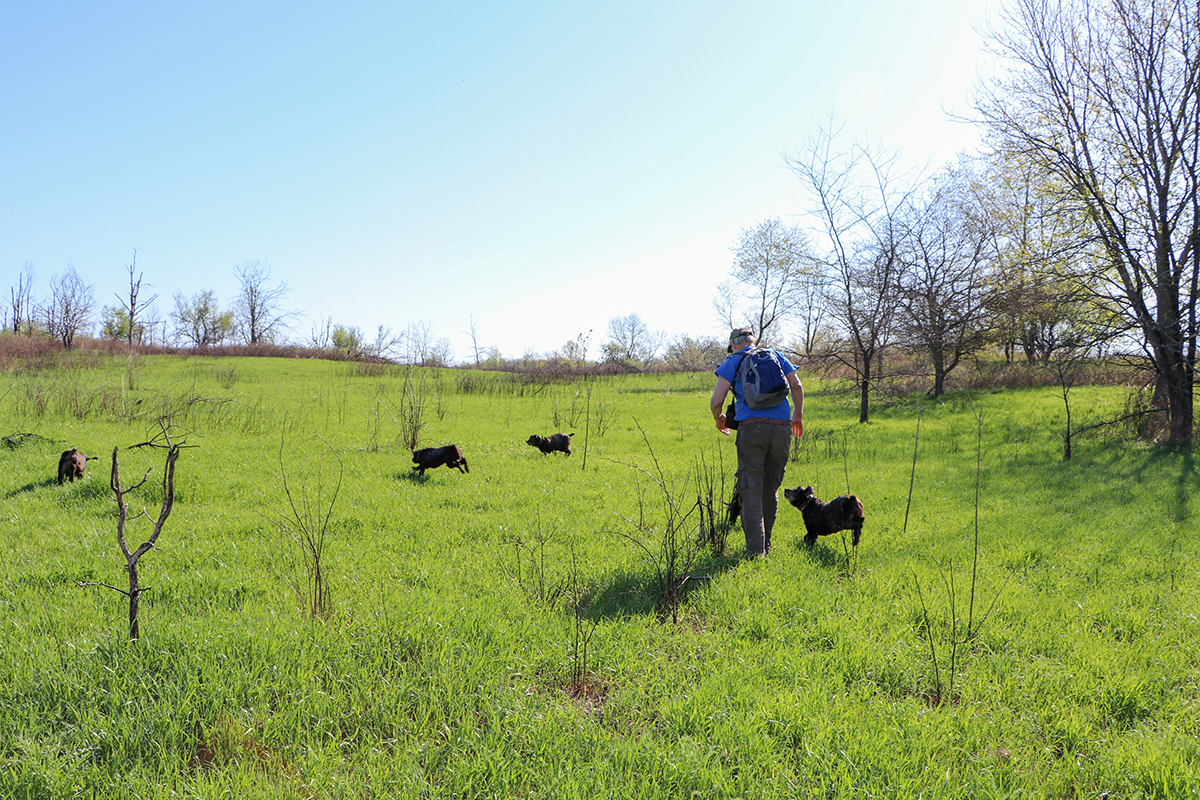
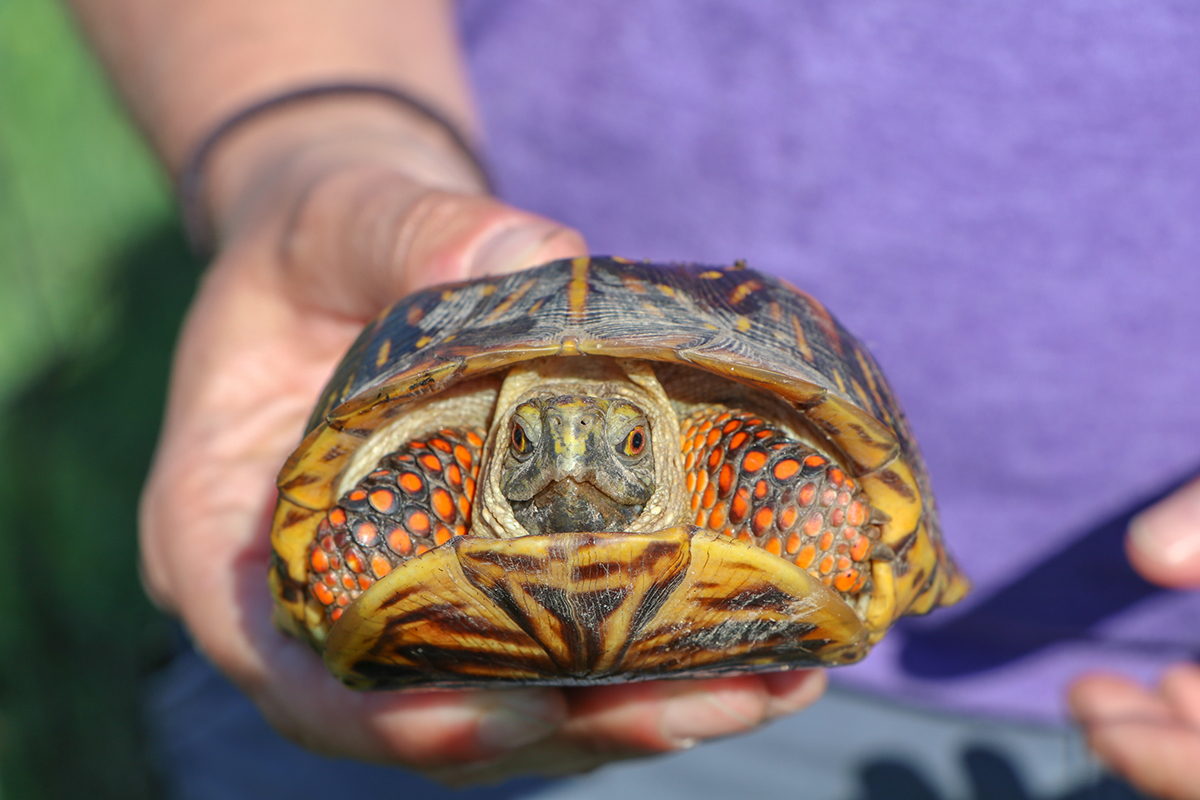
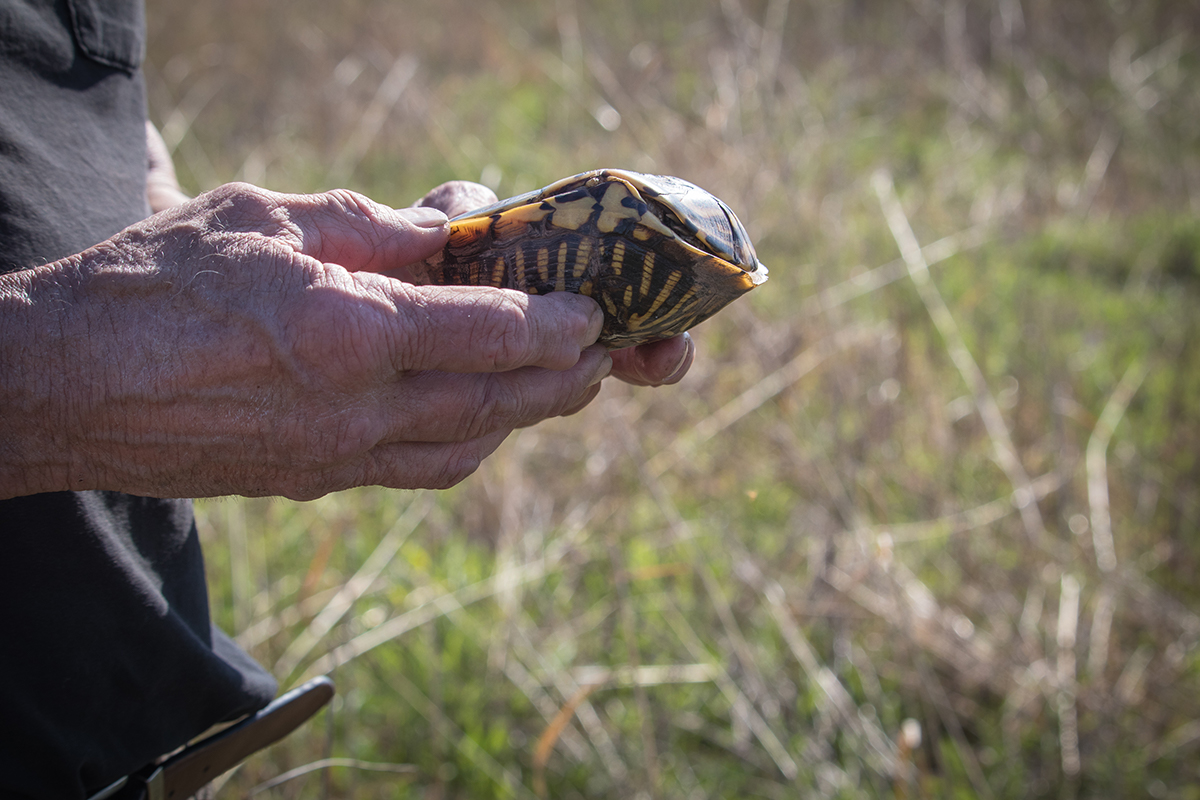
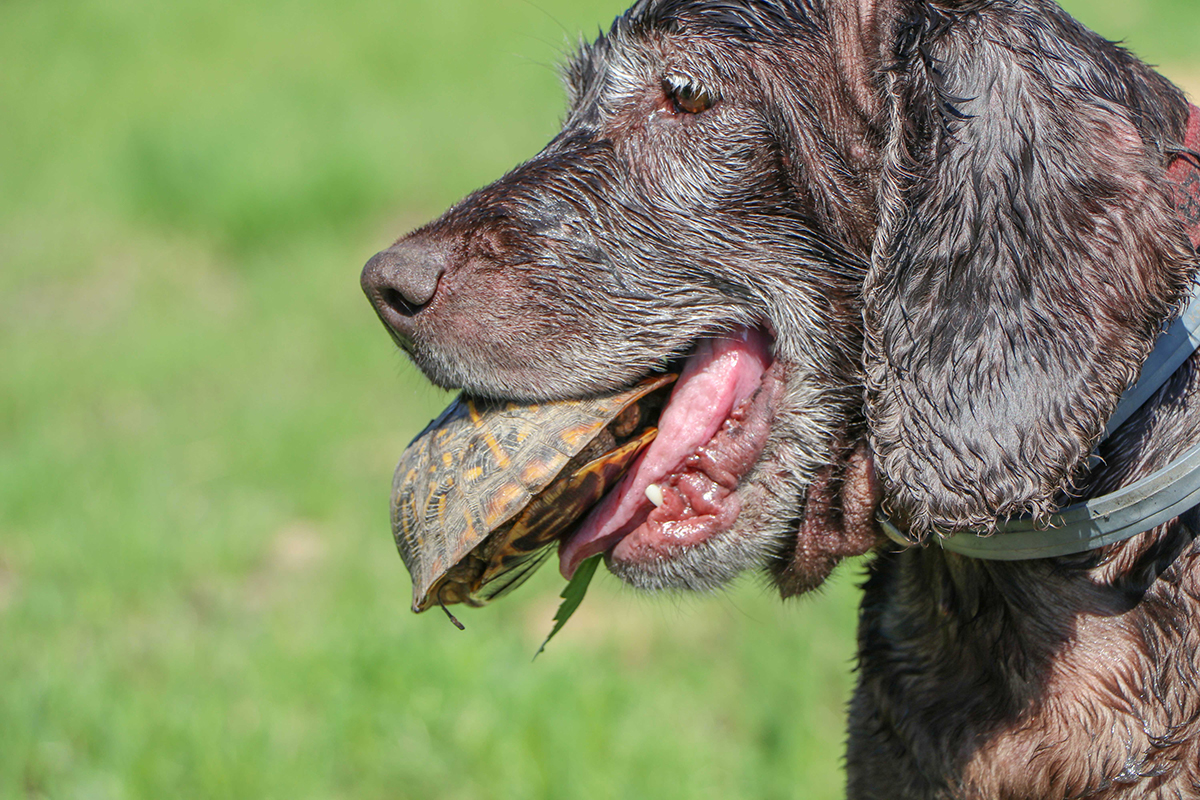
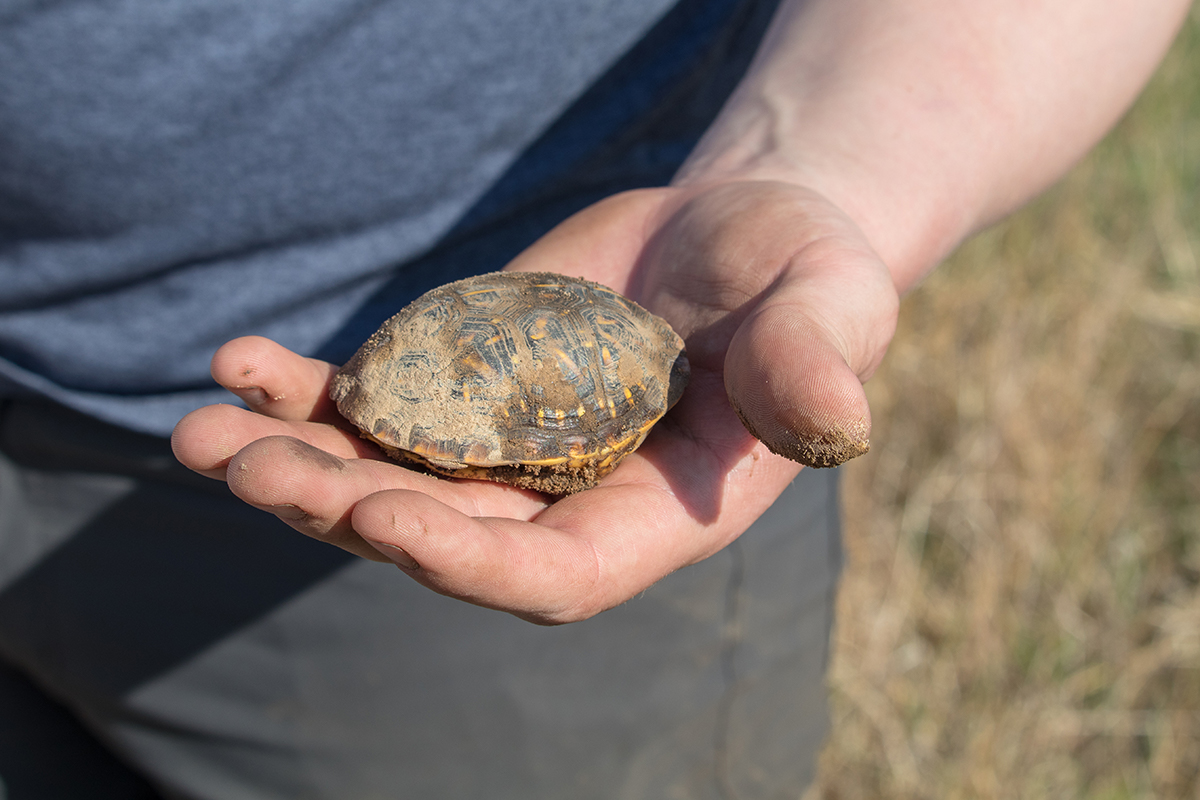
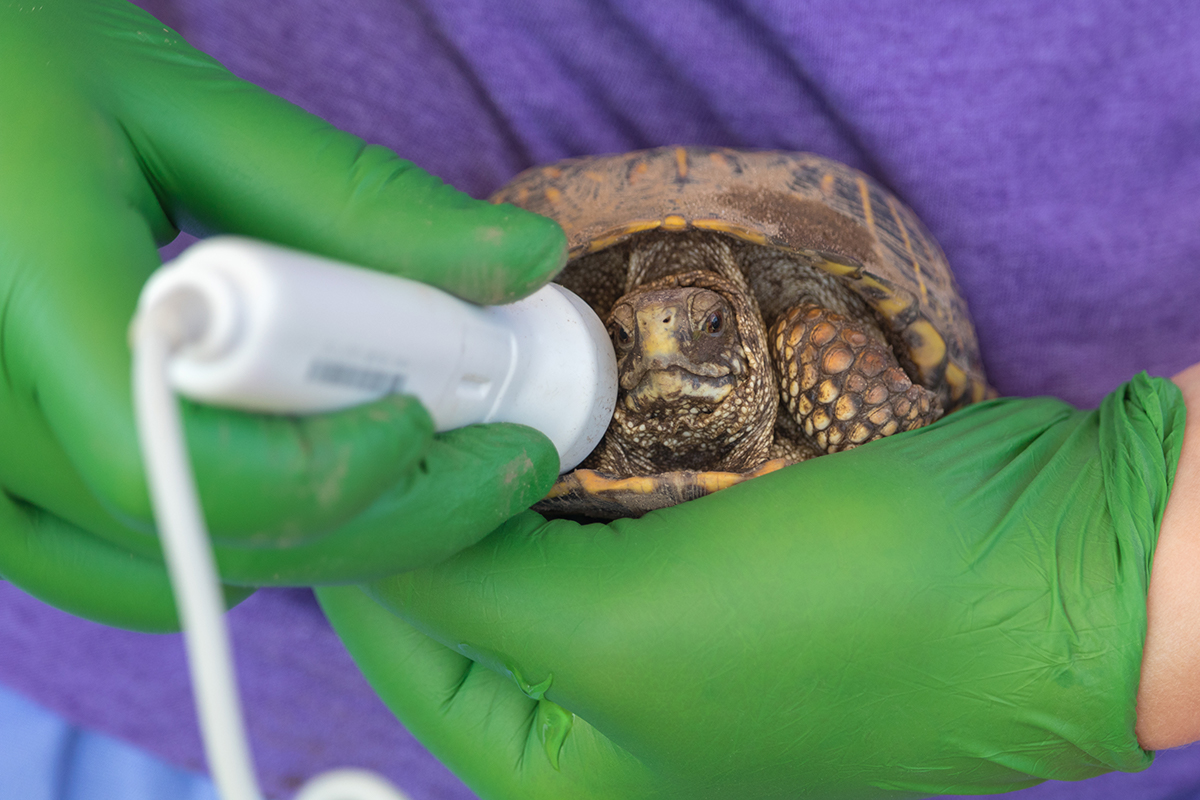
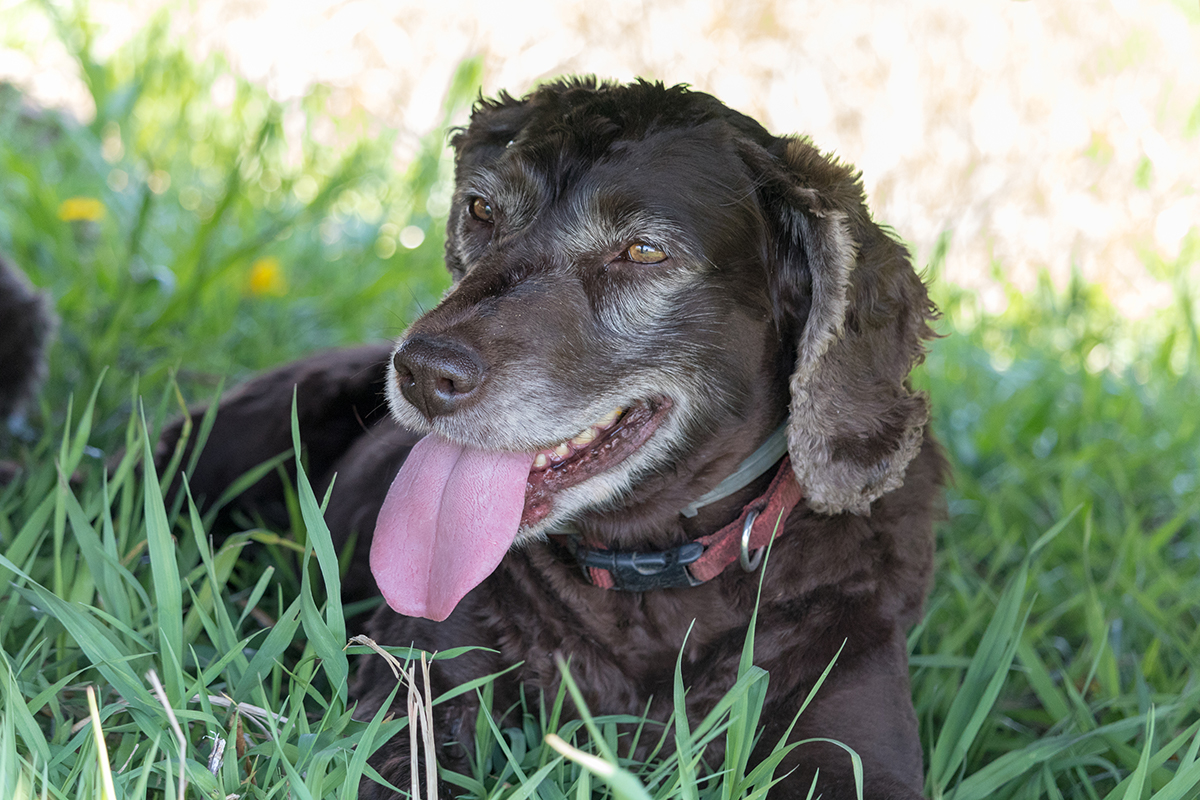
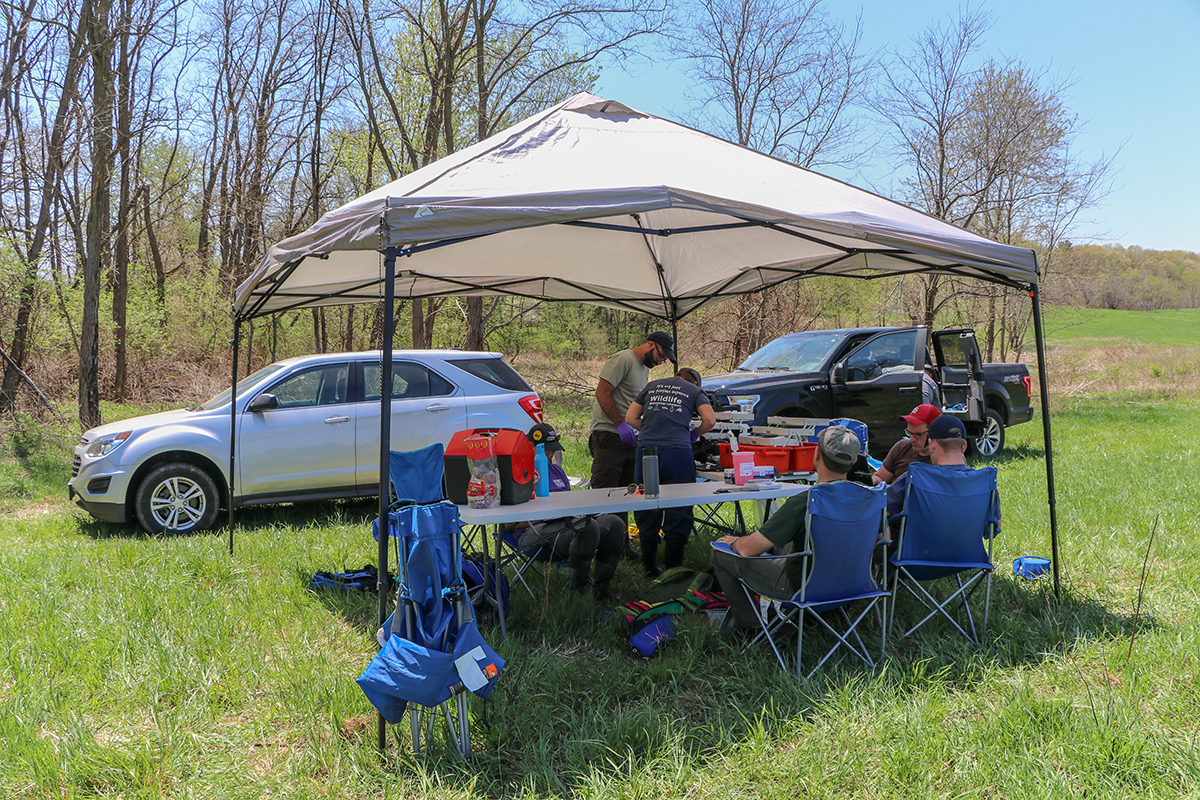
That’s the beauty of my day with the turtle dogs at Nachusa – even as field science becomes more and more high tech with portable DNA sequencers and fetal heart rate monitors with transducers small enough to fit under an ornate box turtle’s shell, there’s still nothing like muddy boots canine-assisted field science to get the job done.
Because, ultimately, it’s not just about the turtles. It’s about what the ornate box turtle populations at Nachusa Grasslands signal about the health of the preserve overall.
“We need to understand the turtles,” Kleiman explains, “because they are such a signature prairie species. If we have healthy population numbers, with many different ages of individual turtles, then we know that our prairie – our remnants and restored prairies – are functioning the way they’re supposed to. The turtles help us know if we’re succeeding or failing.”
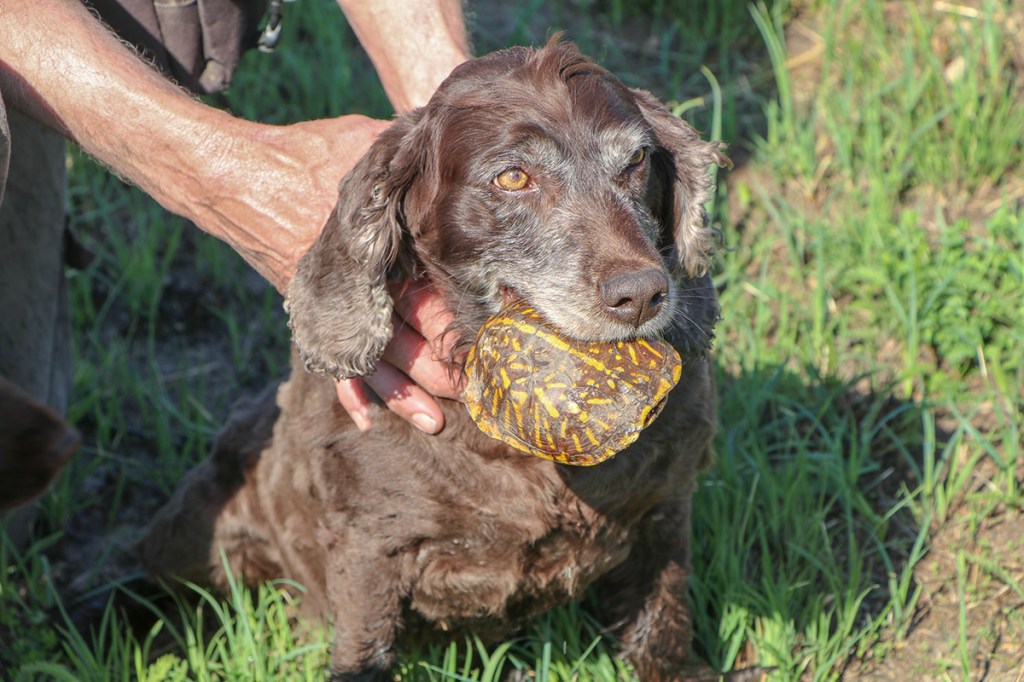



Thanks for this story. It reminded me of my old lab mix dog. She loved finding & picking up ornate box turtles to carry home. She was especially fond of picking up the babies and transporting them with her mouth closed. “Birdie, do you have something in your mouth?” With that, she rolled out a baby off of her tongue. Of course I had to return the turtles to where she found them.
Unfortunately these turtles have now become rare here.
I loved this story because it was so informative. Never knew that dogs could do this. They are so gentle!
Hope that the project is successful!
Wow the wonder of it all ….. Good work..
love this, as I love turtles…keep up the good work..the dogs seem to enjoy this, plus its good exercise for the, until they find something to roll in…wow…lol
All’s well, except that there is always the issue of animal cruelty the minute you start exploring these turtles, whether it’s by a vet , taking a DNA, checking all the way down heart organs and all…”we need to understand the turtles” Kleiman says, at what cost! and after all tests & exploitation you’ll return them back to their original location, in what condition will these little animals be after all??? Do you expect them to survive it all??? of course not, would you, a human??? All in the name of science ….sad, very sad that animals can’t be left alone to live their lives, meaning all animals!
Animal cruelty is quite a stretch. I’m sure the turtles would prefer not to be picked up and prodded, but think about what a wild turtle goes through in nature- being hunted by raccoons or run over by cars. This monitoring by the scientists is for a good cause and is hardly a threat to their survival. Science like this is how we know if a species or ecosystem is in decline. Without understanding the environment or the wildlife that depends on it, we can’t hope to help when they are in need.
Keep a sharp lookout for box turtle “Bekins” whom we rescued from near disaster in Tulsa, Oklahoma while we were renting a townhouse in 1970. Bekins enjoyed many months of pampering with shelter, interaction with Claire while I was at work, and an excellent diet. Every morning when Claire opened the draperies Bekins would scamper over for his ration of hamburger, lettuce, and cherry tomatoes. Alas, one morning he didn’t scamper over; he was gone, never to be seen again. We ruled out predators such as raccoons because a high fence surrounded the patio he lived in. We can only hope he landed in friendly territory. Keep up the good works.
Cara,
I just read your article and Matt’s–Nice job by the both of you. Interesting, useful information that is easily read. Fun too!
Best wishes for cont’d. success,
Len M.
Why does the prairie need the turtles?
Love this article!
Glad to hear we’re trying to make sure these turtles have a chance to survive. Now if only we could come up with some acceptable way to slow population growth which is the greatest threat of all to natural plants and animals.
The Dogs are amazing and do a wonderful job retrieving turtles in a short time. Something it would take man hours to do.
Most enlightening article with lots of details. Makes one wish to participate in this experience. Congratulations to this team in the field for their work.
Thank you for this beautiful story. So wonderful to read of the successful work of the Turtle dogs. The pictures are beautiful! I had an African Spur Thigh for many years from a 3 inch baby that we took to Colorado from Texas and then back to Texas years later. She had a very large yard to graze in and a protected shelter with heating and a/c that my husband built for her. Circumstances
became such that we had to move to a smaller home with practically no yard and we made the difficult decision to give her up. She went to live on a ranch where she had ample room to roam and the company of other turtles like herself. We missed her terribly . She and our Siamese were pals that enjoyed each other’s company for many years.
i am in favor of this research if in the process there are no lab on the turtles that are torturous painful. i think the area can boarded off to keep them safer
I remember many of these turtles during my childhood in Eastern Pennsylvania. We always had one or two that hung around the house and we loved them. How do the turtles the dogs gather taken back to
their territories? I didn’t see that mentioned I the article. I love the dogs. They are so precious with the turtles.
Thank you,
Linda Barnes
Hi Linda — thanks for your note. I love turtles, too. The scientists carefully mark the location where each turtle is found with GPS and then return them back to their individual coordinates. It’s a very detailed and documented process.
Hello:
Good article. This would be an excellent project to develop for the endemic and endangered box turtle, Terrapene coahuila, in Cuatro Cienegas, Coahuila, which is well on its way to extinction. If you would know someone that would be interested in pursuing this, I could probably find a contact for you within the scientists working there, presuming someone there would be interested.